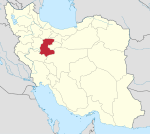Mahallat
| Mahallat محلات | |
|---|---|
| city | |
|
Khorheh ruins near Mahallat. | |
 Mahallat | |
| Coordinates: 33°54′40″N 50°27′11″E / 33.91111°N 50.45306°ECoordinates: 33°54′40″N 50°27′11″E / 33.91111°N 50.45306°E | |
| Country |
|
| Province | Markazi |
| County | Mahallat |
| Bakhsh | Central |
| Population (2006) | |
| • Total | 35,319 |
| Time zone | IRST (UTC+3:30) |
| • Summer (DST) | IRDT (UTC+4:30) |

Mahallat (Persian: محلات, also Romanized as Maḩallāt; also known as Mahallāt Bāla and Maḩallāt-e Bālā)[1] is the capital of Mahallat County, Markazi Province, Iran. At the 2006 census, the city had population of 35,319—10,285 families.[2]
In ancient times it was an important location for Zoroastrianism. It has a cold climate, and strong winds during spring and summer. The city is one of the major producers and exporters of flowers in Iran. Every September the city holds a flower festival. In addition, the area surrounding the city is rich with travertine deposits, which are refined into tiles in nearby factories.
There are remains of Hellenistic architecture from Alexander the Great's time in Mahallat as well as fire temple ruins dated from the Zoroastrianism era. The city is famous for a large warm water spring flowing from mountains in the North into the plain areas of the South, which are used for agriculture as well as the urban water supply. There are also hot springs not far from the city which have been a source of local tourism since ancient times due to its assumed medical benefits. The dialect spoken in Mahallat is a version of a larger branch of dialects spoken in central Iran (Yazd, Isfahan, Khonsar) with several words having a noticeable connection to old Persian.
Mahallat was formerly divided into three major parts. The northern part was Mahallat-e Bala, the area of the Sadat-e Mahallat, the families descending from the prophet Mohammad. In the middle Mahallat-e Ghaleh, originally a vast open space with fields, but in the 18th century two brothers from Sabzevar and their soldiers and servants built castles and developed the area. The family was later known as Amiri, Amirkhani, Elahi, Nassei, Norouz nasseri and Khosrovani (Mahallati). The southern part was named Mahallat-e Pain and this was where the Aga Khan built his huge castle.
The First Iranian to become a US citizen, Hajj Sayyah Mahallati and Aga Khan II, a religious leader were born in Mahallat.
References
- ↑ Mahallat can be found at GEOnet Names Server, at this link, by opening the Advanced Search box, entering "-3073407" in the "Unique Feature Id" form, and clicking on "Search Database".
- ↑ "Census of the Islamic Republic of Iran, 1385 (2006)". Islamic Republic of Iran. Archived from the original (Excel) on 2011-11-11.
External links
| Wikivoyage has a travel guide for Mahallat. |
| Wikimedia Commons has media related to Mahallat. |
- 1911 Encyclopedia
- Mahallat News (Persian)
- History of Mahallat (Persian)

